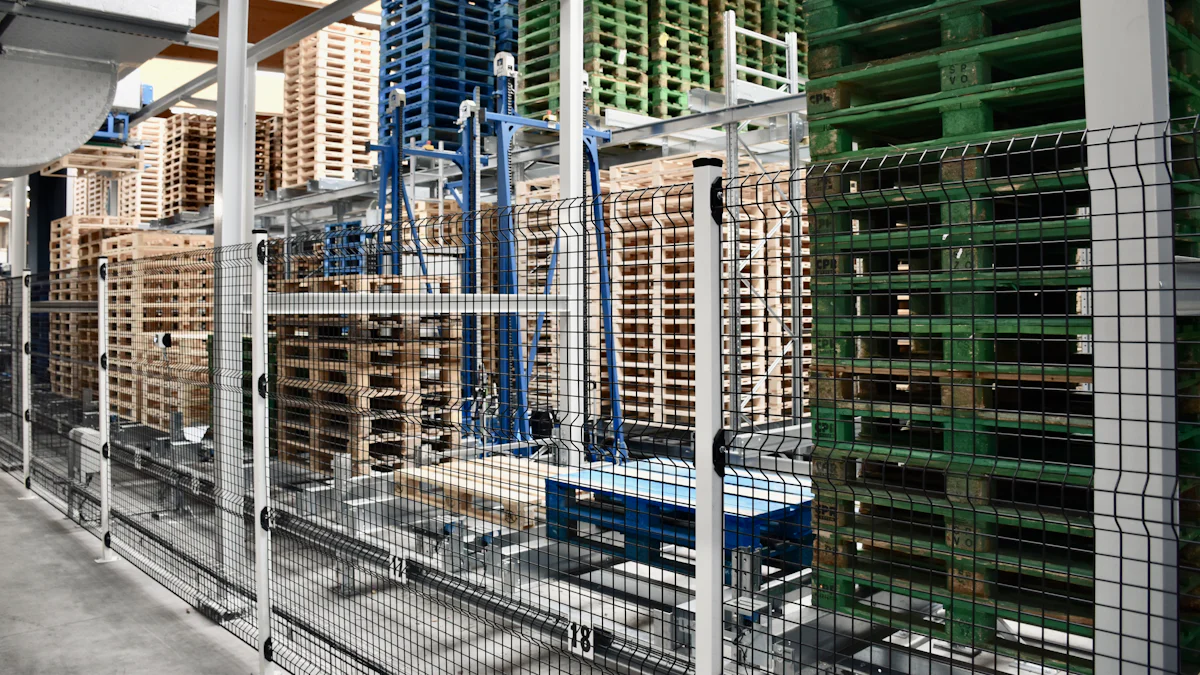The Complete Manual for Warehouse Management Success

Effective warehouse management plays a crucial role in the logistics industry. The integration of digital technologies transforms warehouses into highly automated environments. This transformation enhances efficiency and productivity. The global warehouse management system market is projected to grow from USD 3.45 billion in 2024 to USD 9.11 billion by 2032. Automation solutions are increasingly adopted across all processes. However, 40% of logistics companies face challenges in upskilling employees to keep pace with technological advancements. Addressing these challenges is essential for achieving success in warehouse operations.
Fundamentals of Warehouse Management
Key Processes in Warehouse Management
Receiving
Receiving serves as the first step in warehouse management. Workers inspect incoming goods for accuracy and quality. This process ensures that the warehouse receives the correct items. Proper receiving prevents inventory discrepancies.
Put-away
Put-away involves moving received goods to storage locations. Efficient put-away maximizes space utilization. Workers use systematic methods to place items in designated areas. This organization facilitates easy retrieval later.
Inventory Storage
Inventory storage maintains the orderliness of the warehouse. Proper storage methods prevent damage to goods. Workers ensure that items are stored under suitable conditions. Effective storage supports accurate inventory management.
Picking
Picking refers to selecting items for customer orders. Workers follow precise instructions to gather products. Accurate picking reduces errors in order fulfillment. This process directly impacts customer satisfaction.
Packing
Packing prepares items for shipment. Workers use appropriate materials to protect goods during transit. Proper packing minimizes the risk of damage. This step ensures that customers receive products in excellent condition.
Shipping
Shipping completes the warehouse management cycle. Workers organize packed items for delivery. Timely shipping meets customer expectations. Efficient shipping processes enhance overall operational performance.
Importance of Process Efficiency
Reducing Errors
Process efficiency plays a crucial role in reducing errors. Streamlined operations minimize mistakes in order fulfillment. Error reduction leads to cost savings and improved customer trust. Efficient processes contribute to a warehouse's reputation.
Enhancing Speed
Enhancing speed in warehouse operations boosts productivity. Faster processes enable quicker order fulfillment. Speed improvements lead to higher customer satisfaction. Efficient operations position a warehouse as a reliable service provider.
Case Studies:
JUSDA's Inventory Management Platform Success Story: JUSDA revolutionized inventory management practices. The platform achieved inventory optimization. Outcomes included reduced holding costs and improved cash flow management.
*Warehouse of the Future: Automation and Digitalization*: Automation and digitalization define modern warehouses. Strategic innovations enhance efficiency and sustainability. Future warehouses rely on these advancements for success.
Role of Technology in Warehouse Management

Warehouse Management Systems (WMS)
Warehouse Management Systems (WMS) transform warehouse management by streamlining operations. These systems offer features like real-time inventory tracking and order processing. WMS enhances accuracy and efficiency in managing warehouse tasks.
Features and Benefits
WMS provides tools for inventory control, order fulfillment, and shipment tracking. These features reduce errors and improve productivity. The system ensures seamless integration with other technologies, enhancing overall warehouse management.
Implementation Strategies
Successful WMS implementation requires a strategic approach. Companies should assess their specific needs and select the right system. Training employees on the new system is crucial for maximizing benefits. Continuous evaluation and updates ensure long-term success.
Integration of Automation
Automation plays a pivotal role in modern warehouse management. Automation plays a pivotal role. Automated tools lift, sort, and move goods efficiently. This integration enhances operational speed and reduces manual labor.
Types of Automation
Automation includes programmable machines and AI-based tools. These tools simplify tasks for workers and increase precision. Automated systems handle repetitive tasks, allowing workers to focus on more complex activities.
Impact on Operations
Automation significantly boosts warehouse efficiency. Faster processes lead to quicker order fulfillment. Improved accuracy reduces errors and enhances customer satisfaction. Automation positions warehouses as leaders in operational excellence.
IoT and Big Data
The Internet of Things (IoT) and Big Data revolutionize warehouse management. These technologies provide insights into operations and enhance decision-making.
Data Collection
IoT devices collect real-time data from various warehouse processes. Sensors monitor inventory levels and equipment status. This data supports proactive management and maintenance.
Analytics for Decision Making
Big Data analytics transforms collected information into actionable insights. Analytics helps optimize inventory levels and forecast demand. Decision-makers use these insights to improve warehouse management strategies.
Best Practices for Optimizing Operations
Inventory Accuracy
Accurate inventory management is essential for warehouse management. Businesses achieve this through effective methods like cycle counting and real-time tracking.
Cycle Counting
Cycle counting involves regular audits of inventory. Workers perform these checks to ensure accuracy. This method reduces the need for full inventory counts. Consistent cycle counting helps maintain precise stock levels.
Real-time Tracking
Real-time tracking uses technology to monitor inventory. Systems update stock levels instantly. This approach minimizes discrepancies and enhances visibility. Real-time data supports informed decision-making in warehouse management.
Space Utilization
Efficient space utilization optimizes warehouse management. Proper layout design and storage solutions maximize available space.
Layout Design
Layout design involves strategic planning of warehouse space. Managers arrange areas to facilitate smooth operations. Effective layouts reduce travel time and improve workflow. Proper design enhances overall efficiency.
Storage Solutions
Storage solutions focus on maximizing capacity. Shelving and racking systems organize products efficiently. These solutions prevent clutter and damage. Well-planned storage supports seamless warehouse management.
Workforce Management
Workforce management plays a crucial role in successful warehouse management. Training programs and performance metrics ensure a skilled and efficient team.
Training Programs
Training programs equip employees with necessary skills. Comprehensive training covers safety and operational procedures. Well-trained staff contribute to efficient warehouse management. Continuous learning keeps the workforce updated with industry trends.
Performance Metrics
Performance metrics evaluate employee productivity. Managers use these metrics to identify strengths and areas for improvement. Regular assessments foster a culture of excellence. Effective workforce management enhances overall warehouse performance.
Comparative Data:
Optimized supply chains achieve 15% lower costs and faster cash cycles.
Integration of JUSDA's platform reduces lead times and costs.
Warehouse management success relies on implementing best practices. Accurate inventory, efficient space use, and skilled workforce management drive operational excellence.
The Future of Warehouse Management

Emerging Technologies
Artificial Intelligence
Artificial intelligence (AI) is transforming warehouse management by enhancing decision-making and operational efficiency. AI algorithms analyze vast amounts of data to optimize inventory levels and predict demand patterns. This technology enables warehouses to automate routine tasks, reducing human error and increasing productivity. AI-powered systems also facilitate real-time tracking, providing managers with accurate insights into inventory status and movement. The integration of AI in warehouse management offers a competitive advantage by streamlining processes and improving accuracy.
Robotics
Robotics plays a crucial role in modernizing warehouse management. Programmable machines perform repetitive tasks such as sorting, picking, and packing with precision and speed. Robots enhance operational efficiency by reducing the need for manual labor and minimizing errors. The adoption of robotics in warehouses leads to faster order fulfillment and improved customer satisfaction. As technology advances, robots become more versatile, handling complex tasks and adapting to changing operational needs. The use of robotics in warehouse management positions companies as leaders in innovation and efficiency.
Trends and Predictions
Sustainability
Sustainability is becoming a key focus in warehouse management. Companies are adopting eco-friendly practices to reduce their carbon footprint and promote environmental responsibility. Sustainable warehouses implement energy-efficient lighting, recycling programs, and waste reduction strategies. These initiatives not only benefit the environment but also result in cost savings and improved brand reputation. The trend towards sustainability in warehouse management aligns with global efforts to combat climate change and create a greener future.
Customer Expectations
Customer expectations are shaping the future of warehouse management. Consumers demand faster delivery times and accurate order fulfillment. Warehouses must adapt to meet these expectations by optimizing processes and leveraging technology. Real-time tracking systems provide customers with visibility into their orders, enhancing transparency and trust. Meeting customer expectations requires a commitment to continuous improvement and innovation in warehouse management. Companies that prioritize customer satisfaction gain a competitive edge in the marketplace.
Effective warehouse management ensures operational success. Key strategies include optimizing processes, leveraging technology, and managing inventory accurately. Actionable insights involve adopting automation and enhancing workforce skills. JUSDA offers transformative solutions that enhance efficiency and customer satisfaction. Their platform supports seamless supply chain operations. Partnering with JUSDA provides access to innovative tools and expertise. This collaboration empowers businesses to achieve excellence in warehouse management.
See Also
The Significance of Automated Warehousing for Business Success
Boosting Warehouse Efficiency with Logistics Robotics
Mastering Manufacturing Success in 2024 Through Supply Chain Tactics
Unveiling the Benefits of Robotic Automation in Warehousing
Embracing the Advantages of High-Tech Automated Manufacturing Warehouses
